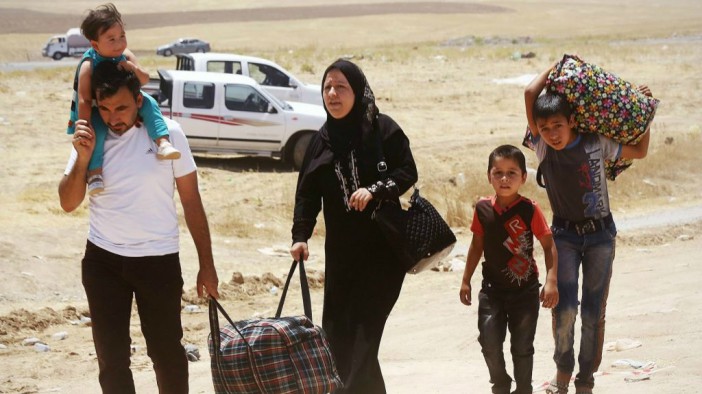Tens of thousands of people fleeing rebels have sought refuge in the small northern Iraqi town of Sinjar, cramming into schools and mosques. But now, there is simply no room left.
“No place remains for us to settle displaced people,” local official Myaser Haji Saleh says despondently.
Huge numbers of people fled a Sunni rebel onslaught on the predominantly-Shiite Turkmen town of Tal Afar last month, part of an offensive that saw swathes of territory across five provinces fall out of government hands.
Some 58,000 of them — mostly children — made their way to Sinjar, further west towards the Syrian border, flooding into a town with a population of around 300,000.
“We opened schools, mosques and shrines for them,” says Saleh, the local official responsible for Sinjar and the surrounding area.
“In the early days, the people provided aid before international organisations arrived,” he says.
“We desperately need to open a camp for them, because our problem lies in housing this large number of displaced people.”
But a camp would create its own problems, as the area lies several hours from the nearest government-held city, and just a short distance from territory controlled by fighters led by the Islamic State (IS) group.
Sinjar is controlled by peshmerga forces from Iraq’s autonomous northern Kurdistan region, and protecting both the town and the camp from insurgents would stretch the peshmerga.
“We are afraid of them being attacked,” says Saleh.
“We cannot exclude the possibility of Daash fighters attacking them with mortars if they were in a camp,” he adds, referring to IS by its former Arabic acronym.
Sinjar is populated mostly by Yazidis, who speak a dialect of Kurdish and live mainly in the mountains of northern Iraq, and the town has long played a key role in Iraq’s struggle with militancy.
The town lies along a well-travelled smuggling route, with the US military seizing a trove of documents near Sinjar indicating that hundreds of militants passed through the area from Syria to Iraq in a one-year period between 2006 and 2007.
And in August 2007, suicide bombers killed more than 200 people in a series of brutal truck bombs in Yazidi-populated villages in the Sinjar area.
Now, the town is grappling with displaced families from Tal Afar fleeing a renewed offensive that started on June 9 and which Iraq’s security forces have struggled to repel.
Sinjar’s sewage system has been overwhelmed by the sudden uptick in its population, while families seeking shelter in a local girls’ school must make do with just one hour of electricity a day indoors or bear the scorching summer heat outside.
Many have even had to set fire to wooden chairs to cook food.
The United Nations voiced fears of overcrowding, poor hygiene and limited access to safe drinking water causing increased instances of diarrhoeal diseases, following a humanitarian visit to the town this month.
“We do not know what to do, or where to go,” says Zainab Jarallah, clinging to her two grandchildren inside the girls’ school.
“We have big families, but we do not have anything. What happened was a surprise for us,” the 68-year-old adds.
“We saw death with our own eyes.”
After seizing Mosul on June 10, IS-led fighters swiftly took control of Sunni-majority areas of five provinces, but Iraqi forces battled for days to keep control of Tal Afar.
On June 23, however, the town fell out of government hands.
Many sought to flee to Dohuk, one of the three provinces in Iraq’s autonomous Kurdish region, but non-Kurds require local sponsors before being allowed to enter.
As a result, countless cars sit idle on the side of the road connecting Dohuk to Sinjar, ostensibly belonging to Iraqis who sought to enter Kurdistan but were unsuccessful.
Those who fled to Sinjar have even sought safety in the town’s shrine to Sayida Zainab, the daughter of Imam Ali and a revered figure in Shiite Islam.
Women sit within the shrine, while men stay outside, watching over their children as they run and play in a nearby graveyard. Others who have not found physical structures have had to settle for tying a large piece of cloth between two parked cars to provide some shade from the sun, including a mother cradling her child, born just two days earlier.
Nearby are 39-year-old Saad Yunus and his 44-year-old brother Ali, both fathers who fled Tal Afar with their families, who have themselves had to resort to similar measures to shield their families from the heat.
“All the roads were blocked to us,” says Saad. “We are trapped here and within days, our savings will run out.
“We do not know what to do.” SAPA






 WhatsApp us
WhatsApp us 

